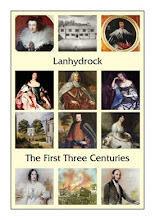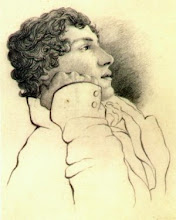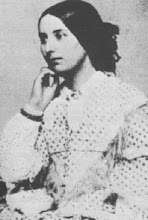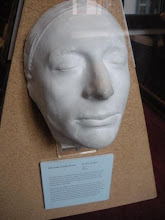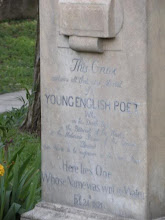Who is she? I don't know. I stumbled upon her while pretending to prepare for my high school students to return. What I do know is this: According to http://www.pariscemeteries.com/pages/about.html, this sculpture is Antoine-Gaétan Guérinot (1830-1891) in division 55, statue by Barrias. So I looked Antoine up. There was a lengthy article in French at http://www.persee.fr/web/revues/home/prescript/article/rvart_0035-1326_1986_num_74_1_347596 entitled the Tombs of Artists which describes the fashion of hiring an artist to immortalize someone as they wish to be seen for eternity. Apparently this was particularly attractive in the 1800's but this does not answer the question: who is the lady in the graveyard?
But Antoine was a man! He was a noted architect of the day. Why was a hauntingly beautiful woman immortalized above a male architect's tomb? I do not know but I have been thinking of her all day. I put on a little Keren Ann, a fabulously atmospheric French singer and wondered. When I left my classroom, the sky was no longer desert blue but stormy and dark.
Coincidence?
Friday, August 21, 2009
Sunday, August 16, 2009
Marie Antoinette: Villanous or Victim?

We all know the story. Even if we don't know the story, we do. The story of the beautiful young queen beheaded by her people is one that lives in our subconcious even if we don't realize it (Sophia Coppella anyone?). Who doesn't feel a pang of horror at the thought of any woman having her best friend butchered, her husband murdered by the people he employs, her children torn from her and finally being killed herself?
Is it gruesome? Is it justice? The two camps were and are rigidly divided.
THE GOOD QUEEN
THE GOOD QUEEN
Grace Darympole Elliot was a British courtesan also went to the Temple Prison. In her memoirs, she recalls the betrayed queen as "virtuous". She says that Marie Antoinette was as "aimiable and good a princess as ever lived." Madame Elliot even goes so far as to say that the Queen's own servants recalled her as "goodness itself", a "kind and most affectionate mistress." Then again, Madame Elliot spent her life as a social climber and professional mistress to scores of royal dupes. So. Why should we care about a Queen who counts Madame Elliot as a friend?
* She was a neglected daughter of the great empress of Austria -- Maria Therese. It is said that she was so neglected by her imperial mother who had another favorite that the girl could barely read and write in German. She also continued to get scathing letters from her mother listing all of her failures as a sovereign and wife from her doting mama.
* She was married off to a stranger at 14 years old and was the laughing stock of France when she and Louis could not consumate the marriage because of his erectile dysfunction. Of course, he was only 15 himself...
* She had to deal with life-term mistresses (the ruthless Madame Du Barry) and other older courtesans who hated Austrians (Seven Years' War). They thought she was a brainless, spineless, childless, twit. At fifteen. Which of course begs the age-old question: why do women do everything in their power to destroy other women?
* She had to deal with life-term mistresses (the ruthless Madame Du Barry) and other older courtesans who hated Austrians (Seven Years' War). They thought she was a brainless, spineless, childless, twit. At fifteen. Which of course begs the age-old question: why do women do everything in their power to destroy other women?
* Her husband hated Austrians (Seven Years' War) and practically said nothing to her. Ever. Which does little to improve erectile dysfunction.
* After Louis's "operation", she had four children but two died and she was left desolate by their passings.
* She was too young to know who her enemies were or how to successfully navigate in any political climate.
* She was too young to know who her enemies were or how to successfully navigate in any political climate.
* Her best friend was dismembered.
* Her husband was beheaded.
* She was spat on, thrown waste at and finally beheaded herself.
* She apologized to the excecutioner for stepping on his feet.
THE INFAMOUS L'AUTRICHIENNE!
L'Autrichienne was the name disappoving old prigs (women) gave the young queen. Translation: The Austrian Woman -- which was a very bad thing coming out of a seven year war with Austria. But they were clever and soon found a way to say L'Autrichienne in such a way that it could combine the hated enemy and the French word for Bitch. Always thinking, those courtesans.... They hated her.
* She was young and beautiful
* She would be queen.
* She was often "loud" and uncouth according to French standards of grace and etiquette.
* She had an addiction to gambling, suitors, and legendary parties.
* She didn't consumate her marriage for seven years. Almost a decade. Which would put her at... that's right... 22.
But let's be honest. Which royal inner circle is warm and nurturing? Which band of beautiful, popular, rich women gets together to improve each other's soul and care more for her friend than for herself? All of these grievances would have remained petty jealousies, irritating but par for the course if the people hadn't risen up and said: "Rawr!!!!" (see yesterday's blog entry).
Life for the peasant in the late 1700's meant a 16 hour work day with a forced FREE labor day during the month (your Sunday, if you please) to do things fun, easy things like, pave the roads. Hey, we all need exercise! It also meant paying taxes to the church, the monarchy and the local nobility out of their crop. Meanwhile, the church, the monarchy and the local nobility were all virtually tax free. They didn't pay a dime. The king had a little something called the lettre de cachet. Roughly translated, this means "Asta la vista, baby." The king could throw you in jail without trial for the rest of your life. Add to all of this a famine where the people who work, build, and pay for the country are starving, you get "unrest."
The people HATED the court but most importantly, they hated Marie Antoinette. More than anyone.
Why?
* The queen had an annual allowance for dresses which came to 150,000 livres which was nearly 300 times greater than the average annual income for one of the schleps paying the taxes for all those dresses.
* She ran up debts, every year, closer to 500,000 livres even though country was in near economic ruin from money spent on wars (one of which was called the American Revolution).
* She was Austrian and constantly suspected of being a spy (which of course the war Austria declared on France during this little misunderstanding didn't help).
* Between the 500,000 for a Queen a la mode and the wild gambling parties, the palace kept 300 cooks, 2000 horses, 700 rooms and 20 kilometers of roads.
* After the revolution began and the reforms had started, the Queen (and king but no one cares about him) took the cap of "liberty" and trampled it under their feet. Probably not a good idea but especially bad when in the middle of a drunken feast when the entire country is starving.
Is this all her fault? Was she a callous, ridiculous woman who drove the people to madness? Was she a pawn in a wider political arena? The fact that France chose a queen who could not read or write with a fetish for debaucherous living is interesting in itself.
But does a silly young woman deserve to die simply because she's silly?
I don't know. I've never watched my family die of starvation while the people I give my food to can't quite keep the dress budget under 500,000 livres.
One last note. When the women from Paris stormed Versailles to demand audience with a queen hiding in her bed chamber, several of them fainted when they saw the splendor of the palace. This was the palace they'd paid for, their husbands and sons, never having known that there was anywhere that beautiful on earth. They almost forgot why they were there: there was no grain, no bread, no food at all in the city and Marie Antoinette was having feasts.
Labels:
Austria,
french revolution,
Louis XVI,
Maria Therese,
Marie Antoinette,
Paris
Friday, August 14, 2009
La Revolution

Why is it that when anyone writes about the French Revolution, they only write about Marie Antoinette? And if not about Marie Antoinette, they write about some silly, vapid, courtesan who spends her days wishing she was Marie Antoinette and her nights sleeping with whichever Count or Marquis it takes to keep her at court?
How is it that after rewriting how Western government views itself, all we remember is: Marie Antoinette -- she had really nice clothes -- she had wild parties -- and then they killed her. Sad.
But it's not the France I know.
The day Coldplay came out with Viva La Vida, I broke out in goosebumps. The colors are glaring and loud with the French symbol of Revolution, a woman brazenly storming the Bastille, half clothed: of course. Ah. The good old days of half naked women on money, telephone ads and art, when the number one rule was LOOK DOWN because you never knew what kind of billboard awaited you on main street or in the middle of centre ville. You know -- BEFORE the Euro?? I lived in France for two years when I was 21. Every week there was a protest, a march, demonstration, a strike. Sometimes they were over the salaries of the postal workers (which they protested by blowing up the local post office at Christmas) and sometimes it was a demonstration by those dissatified with their welfare benefits. Once, I saw the entire Cananbiere lined in Marseilles by Muslims, standing behind miles of machine gun holding troops while a group of French Nationalists marched solemnly up the street holding only a French flag. It was silence as I've never experienced before. Any false move, the wrong insult hurled at the wrong protester or demonstrator and the whole of Marseilles would have gone up in -- dare I say it -- revolution.
It was in those moments that I remembered the revolution, we all did. That it took place in those streets, with ancestors of the people we saw now and left the king probably singing something very similar to Viva La Vida: "I used to rule the world, seas would rise when I gave the word. Now in the morning I sleep alone, sweep the streets I used to own." These days the massive romantic, stone baroque buildings are used as banks, city halls, or community centers. No one speaks of the crowds surging through the streets, the taking over of the ancien regime, the terror that blanketed "Liberite, Egalite, Fraternite." In fact, a French friend of mine was asked to stop singing "Les Marseilles" on Bastille Day as it was offensive to the French people.
Ah well.
No one speaks of LaFayette, Marat, Dantes, or Rousseau, but nobody can seem to erase them entirely either. Even in Viva la Vida, a rock and roll song by a bunch of British lads who probably despise the French as all British lads do, Louis XVI, Robspierre and Bonoparte are still with us. It's even in Broadway musicals like Phantom of the Opera. Christine wanders through the Paris graveyard, a sublimely chilling moment of the Belle Epoque. But what was the Belle Epoque except the time AFTER the revolutions (yes, there were two), AFTER the dust had settled, AFTER we were allowed to associate France with beautiful scenery, clothes, art and not with blood, betrayl, revolution. And let's not forget the Phantom. Older, damaged, scarred... one of les pauvres still taking his vengeance out on the beautiful, privileged upper class.
Who knows what other stories there are of that wildly terrible but essential moment in history? All we ever get are "let them eat cake" stories of whores and buffoons who just happened to be well-dressed enough to matter. Maybe they were the only ones who did matter. But I kind of like to think of the children of the revolution as the ghosts in the Ramalama Bang Bang dance number on So You Think You Can Dance; all heated up, thirsty for revenge and by God, not going to take it anymore. This is the France I lived in. This is the France where I grew up.
Viva la Vida.
Vive La France!
How is it that after rewriting how Western government views itself, all we remember is: Marie Antoinette -- she had really nice clothes -- she had wild parties -- and then they killed her. Sad.
But it's not the France I know.
The day Coldplay came out with Viva La Vida, I broke out in goosebumps. The colors are glaring and loud with the French symbol of Revolution, a woman brazenly storming the Bastille, half clothed: of course. Ah. The good old days of half naked women on money, telephone ads and art, when the number one rule was LOOK DOWN because you never knew what kind of billboard awaited you on main street or in the middle of centre ville. You know -- BEFORE the Euro?? I lived in France for two years when I was 21. Every week there was a protest, a march, demonstration, a strike. Sometimes they were over the salaries of the postal workers (which they protested by blowing up the local post office at Christmas) and sometimes it was a demonstration by those dissatified with their welfare benefits. Once, I saw the entire Cananbiere lined in Marseilles by Muslims, standing behind miles of machine gun holding troops while a group of French Nationalists marched solemnly up the street holding only a French flag. It was silence as I've never experienced before. Any false move, the wrong insult hurled at the wrong protester or demonstrator and the whole of Marseilles would have gone up in -- dare I say it -- revolution.
It was in those moments that I remembered the revolution, we all did. That it took place in those streets, with ancestors of the people we saw now and left the king probably singing something very similar to Viva La Vida: "I used to rule the world, seas would rise when I gave the word. Now in the morning I sleep alone, sweep the streets I used to own." These days the massive romantic, stone baroque buildings are used as banks, city halls, or community centers. No one speaks of the crowds surging through the streets, the taking over of the ancien regime, the terror that blanketed "Liberite, Egalite, Fraternite." In fact, a French friend of mine was asked to stop singing "Les Marseilles" on Bastille Day as it was offensive to the French people.
Ah well.
No one speaks of LaFayette, Marat, Dantes, or Rousseau, but nobody can seem to erase them entirely either. Even in Viva la Vida, a rock and roll song by a bunch of British lads who probably despise the French as all British lads do, Louis XVI, Robspierre and Bonoparte are still with us. It's even in Broadway musicals like Phantom of the Opera. Christine wanders through the Paris graveyard, a sublimely chilling moment of the Belle Epoque. But what was the Belle Epoque except the time AFTER the revolutions (yes, there were two), AFTER the dust had settled, AFTER we were allowed to associate France with beautiful scenery, clothes, art and not with blood, betrayl, revolution. And let's not forget the Phantom. Older, damaged, scarred... one of les pauvres still taking his vengeance out on the beautiful, privileged upper class.
Who knows what other stories there are of that wildly terrible but essential moment in history? All we ever get are "let them eat cake" stories of whores and buffoons who just happened to be well-dressed enough to matter. Maybe they were the only ones who did matter. But I kind of like to think of the children of the revolution as the ghosts in the Ramalama Bang Bang dance number on So You Think You Can Dance; all heated up, thirsty for revenge and by God, not going to take it anymore. This is the France I lived in. This is the France where I grew up.
Viva la Vida.
Vive La France!
Subscribe to:
Comments (Atom)
















